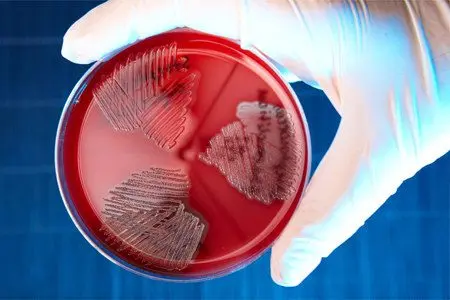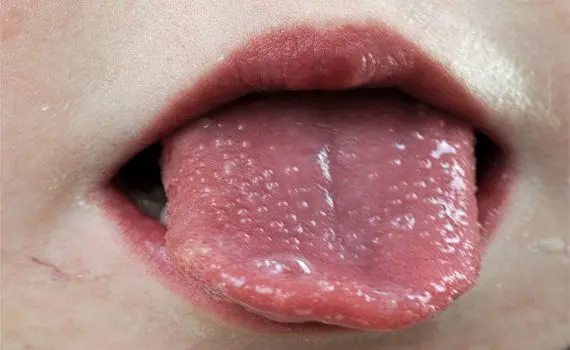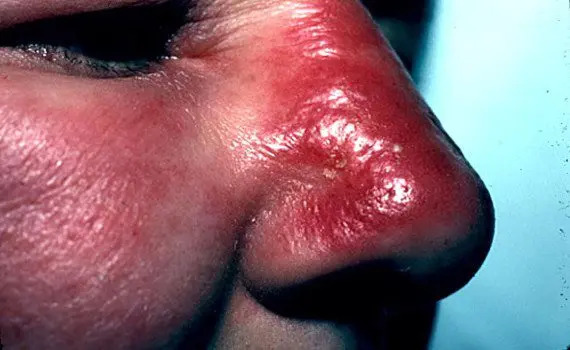Contents
What is a streptococcal infection?

Streptococcus is a genus of anaerobic gram-positive bacteria that cause skin and respiratory diseases. Streptococcal infections are diverse and include pharyngitis, impetigo, scarlet fever, erysipelas, pneumonia, and more. The complications caused by this gram-positive bacterium are especially dangerous: after the disease, the risk of damage to the heart muscle, kidneys, and joints remains.
Streptococcal infections are a group of diseases, each of which can be caused by a different type of streptococcus.
There are three types of bacteria:
Alpha-;
Beta-;
Gamma hemolytic streptococci.
In 90% of cases, streptococcal infection is caused by a beta strain. It also has several varieties: A, B, C, D, F and G. The most widespread subspecies of beta-hemolytic streptococcus A, which is abbreviated as GABHS.
This Gram-positive coccus forms chains of various lengths. It is motionless, it is a cytoplasm, which is surrounded by a membrane and a cell membrane. The optimum temperature for reproduction is 35-37 degrees. At the same time, the microbe retains the ability to increase in numbers in the temperature range of 24-45 degrees.
Bacteria of this group are stable in the external environment. They are not afraid of drying out. At a temperature of 60 degrees, they can maintain their vital activity for half an hour. It will take at least 15 minutes of continuous exposure to destroy them with a disinfectant solution. In dried drops of sputum and pus, they are able to maintain activity for several months.
Pneumococcal infections also belong to the group of streptococcal infections. Their pathogens pose a danger in terms of the development of bacterial pneumonia. In severe cases, they can cause inflammation of the lining of the brain and sepsis.
Every year in Russia alone, more than 10 million children and adolescents suffer from a respiratory form of streptococcal infections, and more than 11 million cases of streptoderma and 616 million cases of pharyngitis provoked by this bacterium are recorded worldwide. There is no such place on Earth where streptococcal infection would not occur. In regions with a cold climate, the bacterium causes respiratory and pharyngeal infections, while skin diseases predominate in southern countries.
Ways of transmission of streptococcal infection

The main route of infection transmission is airborne. The bacteria are found in the saliva and sputum that an infected person produces. They are able to scatter up to 1,5 m. Infection occurs with prolonged contact. In order not to get infected from a sick person, when talking with him, you should keep a distance of 3 m.
How long it remains contagious to others depends on the method of treatment. The sooner therapy is started, the less likely the infection will spread. However, asymptomatic carriage, which can last up to a year, cannot be ruled out. If there is a carrier of infection in the team, then the bacterium will constantly circulate among its members. Favorable conditions for infection are crowding of people, their long-term communication.
In kindergartens, the microbe spreads in playrooms and sleeping quarters. Infection occurs through the use of shared towels, toys, unwashed dishes, untreated door handles, and furniture. Handshakes and kisses promote infection.
It is impossible to exclude the contact-household and alimentary route of transmission of the disease. In the first case, the microbe spreads through dirty hands and household items, and in the second case, with contaminated food that a person consumes. The contact-household method of transmission most often causes skin infections, and airborne – respiratory diseases.
Babies get a streptococcal infection from a sick mother. This can happen both during the passage of the child through the birth canal, and in utero. Also, infection in maternity hospitals, hospitals and clinics should not be excluded.
Streptococcus groups

Streptococci are divided into three groups according to the type of hemolysis of red blood cells:
Alpha hemolytic or yellow — Streptococcus viridans, Streptococcus pneumoniae;
Beta hemolytic — Streptococcus pyogenes;
Non-hemolytic — Streptococcus anhaemolyticus.
For medicine, it is streptococci of the second type, beta-hemolytic, that matter:
Streptococcus pyogenes – the so-called pyogenic streptococci, which cause angina in adults and scarlet fever in children, and give serious complications in the form of glomerulonephritis, rheumatism and endocarditis;
Streptococcus pneumoniae – pneumococci, which are the main culprits of pneumonia and sinusitis;
Streptococcus faecalis and Streptococcus faecies – enterococci, the most tenacious bacteria of this family, causing purulent inflammation in the abdominal cavity and heart;
Streptococcus agalactia – bacteria responsible for most streptococcal lesions of the genitourinary organs and postnatal inflammation of the uterine endometrium in parturient women.
Diseases caused by streptococci

From the group of streptococci, S. pyogenes, a beta-hemolytic streptococcus, is of particular danger. In the Lancefield classification, it is included in group A, therefore it is referred to beta-hemolytic streptococci of group A (abbreviated as GABHS).
Most often, this pathogen provokes pharyngitis and skin infections, which, after 14 days or earlier, are complicated by rheumatism and acute inflammation of the kidneys, with damage to the renal glomeruli (glomerulonephritis).
The bacterium reaches the kidneys and heart muscle through the lymphatic pathways and affected tissues. It can provoke complications, including at the local level. These include: otitis media, peritonsillar abscess, sinusitis, bacteremia. The more severe the infection and the more susceptible the affected tissues, the more intense the suppuration.
The most severe complications of streptococcal infection include blood poisoning, endocardial inflammation, pneumonia, and empyema.
Other strains of streptococci most often provoke the development of soft tissue infections and endocarditis. There are also non-beta-hemolytic streptococci that cause disease in certain populations. In particular, group B streptococci cause infections in pregnant women and infants.
Streptococcal pharyngitis

The causative agent of streptococcal pharyngitis is group A beta-hemolytic streptococci.
Typical symptoms:
Acute tonsillitis.
High body temperature.
The appearance of purulent plaque on the tonsils.
Enlarged lymph nodes located under the neck and under the jaw.
The disease does not always proceed with a vivid clinical picture, so it can be confused with viral pharyngitis. The most common complication of the disease is peritonsillar abscess.
Rhinitis, sinusitis and cough with pharyngitis provoked by streptococci are not observed. These symptoms should suggest the viral or allergic nature of the disease.
In 20% of cases, a person acts as a carrier of the infection, but does not get it himself.
Scarlet fever

To date, the disease is not widespread, but periodically outbreaks of scarlet fever are observed in close-knit teams. Most often – in groups of preschool educational institutions and in schools.
Scarlet fever is diagnosed mainly in childhood. Its causative agent is group A streptococci. Once in the body, they produce a toxin that causes a diffuse rash. If you press on the affected area of the skin, the rash becomes pale.
The rash is especially noticeable on the abdomen and on the sides of the chest. It runs along the folds of the skin, stretches in stripes called Pastia lines. A distinctive characteristic is the pale color of the nasolabial triangle.
The elements of the rash do not exceed a diameter of 2 mm. There are many rashes, they protrude above the surface of the skin, which is why, when touched, it resembles sandpaper. The affected area looks like a person received a sunburn.
The manifestation of the disease is characterized by an increase in body temperature. When it normalizes, the skin begins to peel off. After 5 days, the elements of the rash disappear.
A striking sign of scarlet fever is a crimson tongue. It acquires a rich red color, its papillae become inflamed and become more noticeable.

Among other symptoms of the disease: inflammation of the tonsils, the formation of purulent plaque on them, fever.
Skin infections
Impetigo

Impetigo is one of the manifestations of streptococcal infection. The disease is characterized by the appearance of bullous vesicles, vesicles and pustules filled with fluid. As the infection progresses, they burst, forming honey-colored crusts on the surface of the skin.
Erysipelas

Erysipelas – accompanied by damage to the lymphatic vessels penetrating the dermal layer of the skin. The affected area turns red and swells slightly, gives off a characteristic luster. The edges of the phlegmon are clearly limited. The surface of the infected area is smooth. Painful when touched.
Most often, erysipelas is caused by group A beta-hemolytic streptococcus, but in some cases, other microbial strains become the causative agent of the disease.
Phlegmon

Phlegmon – characterized by a rapid increase in size. It quickly captures new layers of the skin, as the bacterium produces a huge amount of toxins and enzymes. The deep layers of the dermis are affected.
With the disease, there is an increase in body temperature in the affected area. When pressed, a person complains of pain. A complication of phlegmon is skin necrosis.
Necrotizing fasciitis

The disease develops against the background of infection with pyogenic streptococcus. It proceeds hard, it can affect not only the skin, but also muscle fibers. The pathogen enters the body through the skin or through the intestines. The disease is often diagnosed in drug addicts who inject drugs intravenously.
In years past, necrotizing fasciitis was called streptococcal gangrene. It can be caused by several types of bacterial flora at once. Most often, a similar picture is observed when microbes are inoculated through the intestines. Infection can occur during surgery, against the background of perforation of the walls of the organ, in the presence of a diverticulum, or with inflammation of the appendix.
Symptoms:
High body temperature.
Severe pain in the lesion. At the same time, the visible inflammation is not as intense as the sensations it causes. Pain may be the only symptom of infection.
Redness of the skin.
Necrosis of foci of infection. It occurs against the background of blockage of small blood vessels by blood clots and spreads very quickly.
Pronounced intoxication.
Involvement of neighboring muscles. A similar symptom is observed in 20-40% of cases.
Impaired kidney function.
Shock condition.
The danger of the disease is reduced to a high risk of death of the patient. Even promptly prescribed therapy does not always avoid a lethal outcome.
toxic shock syndrome
When infected with a toxin-producing strain of streptococcus aureus, toxic shock syndrome develops. Less commonly, it is caused by other types of bacteria.
SST is most often observed with a decrease in immunity. If a person is healthy, then Staphylococcus aureus provokes mainly skin infections.
Late complications of infection
Complications of a staphylococcal infection can cause the development of autoimmune diseases in the future. Although, how exactly the mechanism of their development is realized is not fully understood.
Rheumatic fever

Rheumatic fever occurs in less than 3% of people who have had pharyngitis, provoked by Staphylococcus aureus, and not cured it. In countries with developed medical care, rheumatic fever is rare. The complication is accompanied by the following symptom complex:
Inflammation of the joints.
Chorea.
Cardite.
Skin rashes.
Laboratory testing is required to confirm the diagnosis. To prevent the development of rheumatic fever, complex treatment of streptococcal pharyngitis is necessary.
Post-streptococcal glomerulonephritis
Poststreptococcal glomerulonephritis is accompanied by kidney damage. The disease develops after suffering pharyngitis or skin infections caused by Staphylococcus aureus. A complication occurs in about 15% of patients. With adequate and timely therapy, it is possible to achieve a complete cure and prevent the transition of the disease into a chronic form.
PANDAS Syndrome
PANDAS syndrome is characterized by tic disorders and obsessional disorders that occur in children after a streptococcal infection. The disease is autoimmune in nature.
Psoriasis
Psoriasis (some of its forms) may be the result of infection with beta-hemolytic streptococcus.
Diagnosis of streptococcal infections

When symptoms of the disease are detected, bacteriological confirmation is required. The delivery of laboratory tests is prescribed for patients with tonsillitis and scarlet fever, with skin infections, toxic shock syndrome, pharyngitis.
Bacterial culture is the main method for detecting streptococcal infection. Material sampling features:
If a smear is taken from the oropharynx, then it is performed in the morning, without prior toileting of the oral cavity. Cotton swabs are used for sampling. At least 2 hours must have passed since the last meal.
A nasal sample is taken with a swab, which is inserted into each nostril to a depth of 2 cm.
If there is a skin test, then the area is pre-treated with alcohol. Then the vesicles are punctured.
With erysipelas, the material is taken using a needle. Before that, 0,1 ml of saline is injected into the affected area.
If the infection is localized in the lower respiratory tract, sputum is examined, or bronchial lavage is performed.
Additional diagnostic methods are rapid tests, of which there are more than 180 types. All of them detect streptococcus polysaccharide antigen. The first generation tests work on the basis of the agglutination reaction (sensitivity is 55% for coagglutination and 90% for latex agglutination). The second generation of tests is based on the method of ELISA, OMA or immunochromatography. Their sensitivity exceeds 95%. The advantage of rapid tests is the high speed of obtaining results: you can find out the diagnosis in 15-20 minutes.
Treating streptococcal infection

Doctors of different specialties are engaged in the treatment of the disease. It all depends on the location of the infection. The patient can be referred for a consultation with a dermatologist, urologist, nephrologist, pulmonologist, otolaryngologist. Primary diagnosis most often falls on the role of therapists and pediatricians.
No treatment regimen can do without antibiotic therapy. Penicillins are the drugs of choice. However, some strains have developed resistance to them. In this case, the drug is replaced with another group. The course should last at least 10 days. A culture test helps to clarify which drug the bacterium has sensitivity to.
Symptomatic therapy depends on the form of the disease. It is possible to use painkillers and antipyretics. Physiotherapy methods are among the auxiliary measures to combat infection. They are used during the recovery phase.
Bacteriophages in the treatment of streptococcal infection
One of the promising areas for the treatment of staphylococcal infections is the use of bacteriophages. They have the ability to penetrate the bacterial cell and multiply inside it, thereby destroying its structure.
The advantage of using bacteriophages is that they not only reduce the intensity of inflammation, but also allow the formation of an adequate immune response. In this case, the body’s own cells are not affected. They are able to cope with those strains that have developed resistance to antibiotic therapy. Bacteriophages do not disturb the intestinal microflora and have no side effects.
Features of the course of streptococcus during pregnancy

The immune system of pregnant women is reduced, so her body is more vulnerable to microbial flora. When infected with staphylococcus, the symptoms will depend on the location of the infection. The main danger is the spread of bacteria throughout the body. When it enters the urinary and reproductive system, the microbe easily reaches the amniotic fluid, which causes a direct threat to the life of the child.
If a pregnant woman did not receive therapy, then for a newborn, infection with streptococcus threatens with meningitis, sepsis and pneumonia. The disease progresses rapidly, so antibiotic therapy is not always effective.
To exclude the presence of staphylococcus in the birth canal, at the 35th week of pregnancy, each woman is swabbed for flora. If a microbe is detected, antibacterial treatment is indicated. If the risk of infection persists, then the woman should receive an additional dose of the drug 4 hours before the onset of labor.
Prevention of streptococcal infections

To prevent streptococcal infection, the following measures can be taken:
Sanitary and hygienic treatment of the premises of school classes, groups in preschool educational institutions;
Preventive examinations in schools and kindergartens;
Reducing the number and crowding of teams;
Compliance with the rules of personal hygiene;
Wearing a mask in public places;
Additional processing of dishes and equipment that could get microbes;
Regular hand washing with soap.
The high contagiousness and severe course of streptococcal infections is a reason for strict adherence to preventive measures to prevent their spread.










саламтсызбы Менде стафилакок чыгып жатат кандай личения алышым керек